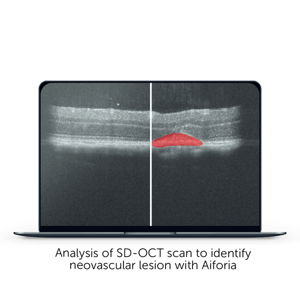Maria Vähätupa, PhD, Project Coordinator & Senior Scientist, and Marc Cerrada-Gimenez, PhD, Director of in Vivo Pharmacology, used Aiforia® Create to design an algorithm that would allow for the analysis of Spectral Domain Optical Coherence Tomography (SD-OCT) scans to identify neovascular lesions on the mouse laser-induced choroidal neovascularization (CNV) model.
When asked why they decided to use Aiforia, they answered, "Aiforia is one of the top companies implementing methodologies to develop specific AI-based algorithms applicable to the research that we are conducting."
Read the full interview below.
Tell us a bit about Experimentica
"Experimentica is a global CRO. We develop and offer an industry-leading portfolio of preclinical ocular models. Our mission statement is to bridge the gap between the development of novel ocular models and their use in developing clinical applications.
The company was founded in 2013 and is headquartered in Kuopio, Finland. We have since grown our operations globally to understand and support local and international pharma and biotech companies as well as academic teams.
Our senior staff originates from academia, so R&D excellence is our corporate culture. We have been involved in several international research programs to leverage our ability to innovate. This resulted in the development of unique in vivo, in vitro, and ex vivo models, as well as forefront capabilities in imaging and artificial intelligence."
What are you using Aiforia’s image analysis software for?
"The mouse laser-induced CNV model is a preclinical model for the neovascular (wet) form of Age Macular Degeneration (AMD). AMD is the main cause of vision loss in people over 65 years. The CNV mouse model partially resembles the human version of the disease, so it is a well-established and widely popular model.
The standard readouts of the CNV mouse model include the analysis of the leakage area from fluorescein angiography scans and the analysis of the CNV lesions by histology at the endpoint. However, as choroid and retina are three-dimensional tissues and the neovascular lesion grows as a 3D mesh it would be ideal to have a fast and accurate methodology for the in vivo quantification of the neovascular lesion volume.
The objective of this project is to identify an efficient and reproducible method to evaluate the volume of choroidal neovascular lesions from the CNV mouse model."
"The AI model allows for the identification and analysis of neovascular lesions from SD-OCT scans of the mouse laser-induced CNV model."

How many images did you need for training your own AI model?
"We ran several tests with various numbers of training images and modified the algorithm parameters, such as region context size, complexity, iterations, etc. until the appropriate parameters were identified. The actual project included 101 annotated training images and 418 analyzed images."
Would you have been able to do this project without Aiforia?
"We would have manually identified the lesion using some kind of image analysis software. In comparison to Aiforia, this method would need to be repeated for every study.
However, now that we have a trained algorithm for the analysis of the images, these can be uploaded and analyzed automatically. Moreover, as the parameters of the analysis are kept constant, it will allow for a direct comparison of the results from different studies."
What was it like working with the Aiforia software?
"The usage of the Aiforia software after the initial training becomes easy as the workflow follows the logic steps in designing and using the algorithm for the selected analysis."
"Aiforia software allowed for the easy design and training of an AI model tailor-made to our analysis."
Read more case studies: